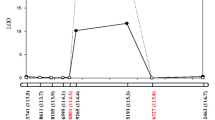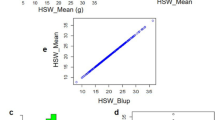Abstract
Pod shattering is an ancestral trait that promotes seed dispersal; however, shattering can have substantial yield losses in cultivated soybean. During the improvement process, American soybean breeders virtually eliminated the shatter phenotype for released varieties, but in other countries, such as Ghana, shatter persists. The objective of our research was to find a molecular tool to implicate genetic shatter susceptibility, validate its usefulness, and apply this knowledge to identify shattering potential in parental lines. Previous research revealed the gene Pdh1 on chromosome 16 plays a crucial role in determining the shatter phenotype. A perfect molecular marker assay was developed to detect alleles of the Pdh1 gene. A genome-wide association study (GWAS) was performed using the Pdh1 allele status as a phenotype and identified a highly associated marker in the SoySNP50K array. Soybean accessions from the National Plant Germplasm System (GRIN-NPGS) with shatter score and SoySNP50K data were evaluated to determine the impact of the predicted Pdh1 alleles on early and late pod shattering. An online tool was developed to enable researchers to query the GRIN collection for the predicted Pdh1 allele status. Lines from an African soybean germplasm collection were analyzed, and it was determined that 22.5% of lines had the shatter-susceptible alleles of Pdh1; two of seven Ghanaian released soybean varieties had the shatter-susceptible alleles of Pdh1. Soybean breeding programs that access germplasm from the GRIN or the African collection can utilize these resources to eliminate the Pdh1 effects on pod shatter and thus improve yield potential.



Similar content being viewed by others
References
Anderson JE, Kantar MB, Kono TY, Fu F, Stec AO, Song Q, Cregan PB, Specht JE, Diers BW, CAnnon SB, McHale LK, Stupar RM (2014) A roadmap for functional structural variants in the soybean genome. G3: Genes|Genomes|Genetics 4:1307–1318
Bailey M, Mian M, Carter T, Ashley D, Boerma H (1997) Pod dehiscence of soybean: identification of quantitative trait loci. J Hered 88:152–154
Bandillo NB, Anderson JE, Kantar MB, Stupar RM, Specht JE, Graef GL, Lorenz AJ (2017) Dissecting the genetic basis of local adaptation in soybean. Sci Rep 7:17195
Bradbury PJ, Zhang Z, Kroon DE, Casstevens TM, Ramdoss Y, Buckler ES (2007) TASSEL: software for association mapping of complex traits in diverse samples. Bioinformatics 23:2633–2635
Carter TE, Nelson RL, Sneller CH, Cui Z (2004) Genetic diversity in soybean. Soybeans: Improvement, production, and uses:303–416
Chen Y, Nelson RL (2004) Genetic variation and relationships among cultivated, wild, and semiwild soybean. Crop Sci 44:316–325
Dong Y, Yang X, Liu J, Wang B-H, Liu B-L, Wang Y-Z (2014) Pod shattering resistance associated with domestication is mediated by a NAC gene in soybean. Nat Commun 5:3352
Fang C, Ma Y, Wu S, Liu Z, Wang Z, Yang R, Hu G, Zhou Z, Yu H, Zhang M, Pan Y, Zhou G, Ren H, du W, Yan H, Wang Y, Han D, Shen Y, Liu S, Liu T, Zhang J, Qin H, Yuan J, Yuan X, Kong F, Liu B, Li J, Zhang Z, Wang G, Zhu B, Tian Z (2017) Genome-wide association studies dissect the genetic networks underlying agronomical traits in soybean. Genome Biol 18:161
Food and Agriculture Organization of the United Nations (2014) FAOSTAT statistics database. http://www.fao.org/faostat. Accessed 5 Feb 2019
Fuller DQ, Denham T, Arroyo-Kalin M, Lucas L, Stevens CJ, Qin L, Allaby RG, Purugganan MD (2014) Convergent evolution and parallelism in plant domestication revealed by an expanding archaeological record. Proc Natl Acad Sci 111:6147–6152
Funatsuki H, Suzuki M, Hirose A, Inaba H, Yamada T, Hajika M, Komatsu K, Katayama T, Sayama T, Ishimoto M, Fujino K (2014) Molecular basis of a shattering resistance boosting global dissemination of soybean. Proc Natl Acad Sci 111:17797–17802
Gao M, Zhu H (2013) Fine mapping of a major quantitative trait locus that regulates pod shattering in soybean. Mol Breed 32:485–491
Goldsmith PD (2008) Economics of soybean production, marketing and utilization. Soybeans Chemistry, Production, Processing, and Utilization:117–150
Grant D, Nelson RT, Cannon SB, Shoemaker RC (2009) SoyBase, the USDA-ARS soybean genetics and genomics database. Nucleic Acids Res 38:D843–D846
Hymowitz T (1970) On the domestication of the soybean. Econ Bot 24:408–421
Hyten DL, Song Q, Zhu Y, Choi IY, Nelson RL, Costa JM, Specht JE, Shoemaker RC, Cregan PB (2006) Impacts of genetic bottlenecks on soybean genome diversity. Proc Natl Acad Sci 103:16666–16671
Joshi T, Patil K, Fitzpatrick MR, Franklin LD, Yao Q, Cook JR, Wang Z, Libault M, Brechenmacher L, Valliyodan B, Wu X, Cheng J, Stacey G, Nguyen HT, Xu D (2012) Soybean Knowledge Base (SoyKB): a web resource for soybean translational genomics. BMC Genomics 13(Suppl 1):S15. https://doi.org/10.1186/1471-2164-13-S1-S15
Joshi T et al (2013) Soybean knowledge base (SoyKB): a web resource for integration of soybean translational genomics and molecular breeding. Nucleic Acids Res 42:D1245–D1252
Joshi T, Wang J, Zhang H, Chen S, Zeng S, Xu B, Xu D (2017) The evolution of soybean Knowledge Base (SoyKB). In: Plant Genomics Databases. Springer, pp 149–159
Kong F, Liu B, Xia Z, Sato S, Kim BM, Watanabe S, Yamada T, Tabata S, Kanazawa A, Harada K, Abe J (2010) Two coordinately regulated homologs of FLOWERING LOCUS T are involved in the control of photoperiodic flowering in soybean. Plant Physiol 154:1220–1231. https://doi.org/10.1104/pp.110.160796
Lam HM, Xu X, Liu X, Chen W, Yang G, Wong F-L, Li M-W, He W, Qin N, Wang B, Li J, Jian M, Wang J, Shao G, Wang J, Sun SS-M, Zhang G (2010) Resequencing of 31 wild and cultivated soybean genomes identifies patterns of genetic diversity and selection. Nat Genet 42:1053–1059
Liu B, Fujita T, Yan Z-H, Sakamoto S, Xu D, Abe J (2007) QTL mapping of domestication-related traits in soybean (Glycine max). Ann Bot 100:1027–1038
Liu Y, Khan SM, Wang J, Rynge M, Zhang Y, Zeng S et al (2016) PGen: large-scale genomic variations analysis workflow and browser in SoyKB. BMC Bioinformatics 17(Suppl 13):337
Masuda T, Goldsmith PD (2009) World soybean production: area harvested, yield, and long-term projections. Int Food Agribusiness Manag Rev 12:143–162
Nguyen H, et al. (2018) Large scale soybean genome re-sequencing consortium, pre-publication. https://soybase.org/projects/SoyBase.B2014.02/resequencing%20data%20usage%20policy.htm. Accessed May 2018
Saxe L, Clark C, Lin S, Lumpkin T (1996) Mapping the pod-shattering trait in soybean. Soybean Genetics Newsletter (USA)
Singh U, Singh B (1992) Tropical grain legumes as important human foods. Econ Bot 46:310–321
Song Q, Hyten DL, Jia G, Quigley CV, Fickus EW, Nelson RL, Cregan PB (2013) Development and evaluation of SoySNP50K, a high-density genotyping array for soybean. PLoS One 8:e54985
Suzuki M, Fujino K, Funatsuki H (2009) A major soybean QTL, qPDH1, controls pod dehiscence without marked morphological change. Plant Prod Sci 12:217–223
Tefera H, Asafo-Adjei B, Dashiell KE (2010) Breeding progress for grain yield and associated traits in medium and late maturing promiscuous soybeans in Nigeria. Euphytica 175:251–260
Wansink B, Cheong J (2002) Taste profiles that correlate with soy consumption in developing countries. Pak J Nutr 1:276–278
Zhou Z, Jiang Y, Wang Z, Gou Z, Lyu J, Li W, Yu Y, Shu L, Zhao Y, Ma Y, Fang C, Shen Y, Liu T, Li C, Li Q, Wu M, Wang M, Wu Y, Dong Y, Wan W, Wang X, Ding Z, Gao Y, Xiang H, Zhu B, Lee SH, Wang W, Tian Z (2015) Resequencing 302 wild and cultivated accessions identifies genes related to domestication and improvement in soybean. Nat Biotechnol 33:408–414
Funding
This work was supported by the US Department of Agriculture-Agricultural Research Service. This research is in part funded by the USAID Feed the Future Lab for Soybean Value Chain Research. The award number is Cooperative Agreement Number AID OAA-L-14-00001.
Author information
Authors and Affiliations
Corresponding author
Ethics declarations
Conflict of interest
The authors declare that they have no conflict of interest.
Additional information
Publisher’s note
Springer Nature remains neutral with regard to jurisdictional claims in published maps and institutional affiliations.
Rights and permissions
About this article
Cite this article
Miranda, C., Culp, C., Škrabišová, M. et al. Molecular tools for detecting Pdh1 can improve soybean breeding efficiency by reducing yield losses due to pod shatter. Mol Breeding 39, 27 (2019). https://doi.org/10.1007/s11032-019-0935-1
Received:
Accepted:
Published:
DOI: https://doi.org/10.1007/s11032-019-0935-1




